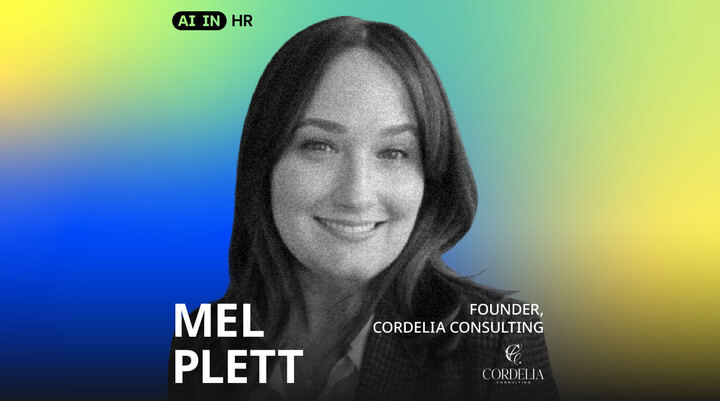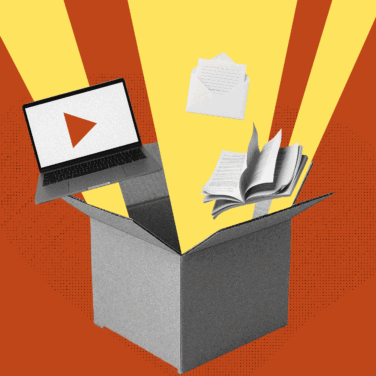Mel Plett is the Founder of Cordelia Consulting and co-host of Your Work Friends, where she researches and discusses the future of work.
We sat down with Mel to get her thoughts on the shift toward AI in leadership — and how important the human element is becoming. Here's what she had to say.
Leading at Every Level, From Manager to Executive
I'm the founder of Cordelia Consulting and co-founder and co-host of Your Work Friends. My leadership journey started long before I began a career in HR. It started in sports and retail, where I learned that real leadership is about teamwork, trust, and showing up for people.
I've spent my whole career across all pillars in HR and talent (Big Law/Big 4), leading at every level from manager to executive. My work has always been about balancing what the business needs with what people need to do their best work.
The biggest lesson I've learned from my journey is that leadership isn't about having titles or having all the right answers. It's about listening, asking better questions, and shaping workplaces where people see their impact. That's still the work I get to do every day with leaders and organizations.
Leadership isn't about having titles or having all the right answers. It's about listening, asking better questions, and shaping workplaces where people see their impact.
Why Human-Centered Leadership Is Needed in an Ai-First World
Leadership hasn't changed as much as people might think in an AI-first world. At its core, it's still about trust, transparency, and supporting people in doing their best work. That's the stuff that fuels innovation and business success.
If anything, the need for those core leadership skills has only intensified. What's different now is the urgency to really lean into our distinct human capabilities like judgment, creativity, curiosity, and empathy.
Because the leaders who thrive in the next five years won't be the ones who know the most about AI, but the ones who know the most about people.
The leaders who thrive in the next five years won’t be the ones who know the most about AI, but the ones who know the most about people.
As more technical and operational work gets automated, leadership will shift to being almost entirely about forming deep relationships, providing transparency, building trust, and helping others connect to their purpose. The command-and-control, hierarchical style that some leaders still cling to (I'm talking to those who demand RTO) will disappear. That type of leadership just kills innovation and drives talent away.
The leaders who lean into the people side will be the ones driving the innovation and resilience that strategy depends on, and those are the leaders shaping the businesses that will survive and grow in the future.
The Moment That AI Became a Thought Partner
That said, AI is a valuable thought partner.
About three years ago, right when AI was hitting the scene and really gaining traction, my team and I were building a cross-business curriculum strategy and a three-year roadmap tied directly to the goals of a scaling business. We had data coming in from every angle: skills, competencies, performance management, talent acquisition, and a collection of qualitative and quantitative broader business needs.
Normally, we would have pulled it all together manually, a team and a wall full of sticky notes to get through synthesis. I love a good sticky note, but we used AI instead to help us sort through and make sense of it all. What stood out to me immediately was how it gave us a fuller picture and highlighted opportunities we might have missed.
One clear example was realizing we needed to start building key leadership capabilities much earlier than we had been, which shifted how we shaped the roadmap and our programs. It also helped us to pressure test our recommendations against what was happening in the market.
I have led digital strategy and HR tech initiatives throughout my career, so I have always been an early adopter, but a cautious optimist. That moment with my team confirmed for me that AI was not about replacing our judgment; it was a tool to help us see our blind spots and provide thought partnership to make smarter decisions. We very much had a test-and-learn environment with the guiding principle that AI was a tool to help support our thinking but never replace it.
How AI Is Transforming Workflows, Strategy, and Decision-Making
One of the biggest shifts I've made with AI is in how I capture and use input across the business. I can take information from workshops, interviews, and research and organize it in a way that shows themes and gaps I might have missed before.
It has changed the way I approach strategy and org design considerations because I can surface patterns that might not have stood out otherwise. It makes it much easier to pressure test scenarios. For example, I used it to analyze spans of control and layers of management to see what would happen if a layer was flattened.
AI helped me analyze the impact of making a change not just against internal reporting data, but also against employee feedback and external benchmarks, which surfaced the risk of stretching teams too thin while the business was pushing for faster execution. Having that kind of view earlier in the process allows me to bring those trade-offs into the room sooner, and that leads to better conversations and better choices.
The Tools That Power Modern HR and Leadership
I'm a fan of lean tech stacks; otherwise, you risk creating frankentools.
My core tools are:
- Google Workspace with Gemini
- Otter for AI note-taking and summaries
- I use ChatGPT, Perplexity, and Claude for research, thought partnership, analysis, and even for developing code for my website.
- And I've been exploring lightweight agents, like Reclaim and Motion for task tracking and efficiency to see how they fit.
I also subscribe to There's an AI for That just to see what's out there and to play around. There's a lot of fun stuff, and I think it's important to play to learn.
Why Otter.ai Is a Secret Superpower
This might sound simple and maybe even boring, but Otter.ai is my game-changer.
Note-taking is critically important, but it often takes away from my ability to be fully present in a conversation. Otter gives me the space to stay fully present and engaged without worrying I'll miss something important.
It has surfaced insights I might have overlooked before, and it gives me the chance to reflect after a call on what information I still need and what actions to take. Sometimes the simple and boring solution is the best one.
Sometimes the simple and boring solution is the best one.
I use Otter.ai in several ways. Here are a few examples:
- Coaching clients - capturing client reflections so they can stay fully present in the moment. It lets both me and the client go back and pull language for themes, patterns, and blind spots they may not have noticed.
- Qualitative research/discovery - when interviewing employees, stakeholders, or leaders during a needs analysis. It makes it much easier to tag recurring themes or pressure points across conversations.
- Stakeholder interviews for strategy work - capturing multiple perspectives across the org (executives, managers, frontline) so I don't lose nuance. Helps to compare and surface disconnects.
- Training and Workshops - helps to keep a live record of ideas, decisions, and tensions in group settings.
- Round tables and focus groups - helps me to summarize discussion points in real time so I can move from conversation to action faster. It also gives me material to create post-session insights and next steps.
- Client presentations and feedback loops - helps to record the conversation around recommendations so I can reflect on objections, concerns, or opportunities that clients surface in the moment. It captures any 'off-script' comments I might otherwise miss in the moment.
- Personal development - feedback discussions and even when I'm attending conferences (where it is allowed) to help me summarize key takeaways for future reflection and use.
But I only use it if clients have opted in.
AI Is Not a Strategy; It’s a Tool
It's important to realize that AI is not a strategy in itself. It's a set of tools.
The strategy is still about products, services, and people. How you build trust, how you unlock creativity, how you help teams do their best work so they can deliver to customers and clients.
Leaders who treat AI as the destination will get stuck. Leaders who treat it as a helper in service of their people and business strategy will move forward faster.
How to Avoid Creating Human Debt™ With AI
It is also not a perfect solution, just like every other wave of tech before it. It works best as a thought partner, research partner, even accountability partner, but it's not a replacement.
What matters most is asking:
- What do humans need to do?
- And where can AI have the greatest impact in achieving that?
The real value comes in what it frees up, like more time for creativity, connection, even innovation, but only if we do the hard work of analysis first. If organizations and leaders skip that first step, we risk building up what Duena Blomstrom calls Human Debt™, the gap that grows when we ignore the human side of change, especially when it comes to technological changes.
For me, that has been the biggest 'aha'. AI hasn't reduced the need for human judgment; it has raised the bar.
AI hasn't reduced the need for human judgment; it has raised the bar.
Closing the Gap Between Ai’s Promise and Organizational Reality
The promise of AI always sounds bigger than the reality of how it shows up inside organizations. In my work, I'm talking to leaders and employees every week, and I hear the same themes. There is an expectation to use it, but no guidance on how or where it will have the greatest impact.
As a result, people are often left feeling like, what now? On one side, leaders talk about efficiency, but employees are often worried about what that means for their jobs.
If you don't build trust and clarity, the tech won't get used in meaningful ways. Another gap is around data. AI is only as good as the information it is given, but I see a lot of orgs treating AI outputs like magic solutions for every business issue. AI still makes a lot of mistakes, and without context and judgment, it can create a whole lot of bad decisions.
Another disconnect I see is structural. Companies want innovation and the agility that AI promises, but they still operate in rigid hierarchies that slow everything down, like turning a cruise ship. In my work, I recommend leaders close these gaps by making AI adoption people-first, by pressure testing the insights against real-world experience, and pushing for org designs that are more adaptable and skill-focused. These aren't perfect solutions, but these small shifts can help orgs use AI in a way that actually supports people and performance.
Practical Steps to Make Teams Ai-Ready
AI literacy is critical to the work that I do with clients. I'm constantly researching and sharing leading practices through consultations, my newsletter, and the experts I interview on Your Work Friends.
What I've seen work best is making AI less intimidating and more practical. That means helping leaders and teams start with their real-world problems they are trying to solve, then showing how AI can support them without adding more noise to the mix.
For me, being AI-ready isn't about having a bunch of tools; it's about experimenting, asking better questions, understanding where AI can have the greatest ROI, and where human work still matters the most.
Leadership Advice for Navigating AI Transformation
All in all, put people first. Even with all the new tech, what people want from leaders hasn't changed. They want clarity, trust, to know they're valued and have impact, and they want a sense of purpose. We work 90,000 hours over the course of our lifetime, and we want to feel like it counts. Leaders play a critical role. Keep that front and center.
With AI, start small, stay curious, and don't chase perfection. Focus on solving real problems in your real-world scenarios, and invite your team into it from the start so the change is collaborative, not an order.
For example, I worked with a client who wanted his team to learn how to use AI in their day-to-day work. We designed a four-week AI sprint that was set up like a friendly competition. Each week, the team met for an hour and spent 10 minutes each sharing an AI solution they had tried on a real ops task, with one slide showing the process they improved, the impact on stakeholders, and the business value (savings on time, money, resources, and impact to strategy).
By week four, they had four working solutions and ran a bracket to choose the most impactful one not only for their team, but also for the org. When they shared those ideas with other departments, it sparked interest and collaboration well beyond their initial team sprint.
This approach worked because it was simple, hands-on, provided psychological safety to experiment, and gave people ownership about the decision. Instead of feeling like AI was a top-down directive happening to them, it became something they discovered and shaped together.
Follow Along
You can follow Mel’s work and thinking through:
More expert interviews to come on People Managing People!



